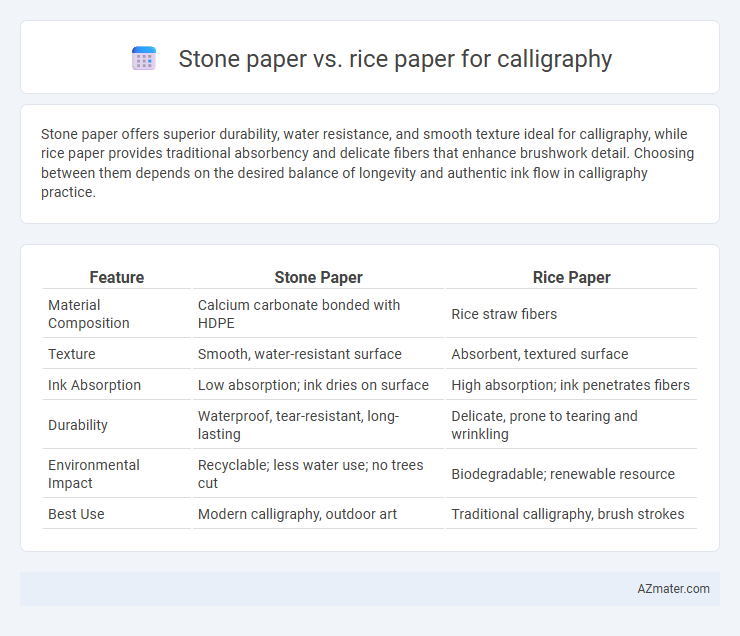Stone paper offers superior durability, water resistance, and smooth texture ideal for calligraphy, while rice paper provides traditional absorbency and delicate fibers that enhance brushwork detail. Choosing between them depends on the desired balance of longevity and authentic ink flow in calligraphy practice.
Table of Comparison
| Feature | Stone Paper | Rice Paper |
|---|---|---|
| Material Composition | Calcium carbonate bonded with HDPE | Rice straw fibers |
| Texture | Smooth, water-resistant surface | Absorbent, textured surface |
| Ink Absorption | Low absorption; ink dries on surface | High absorption; ink penetrates fibers |
| Durability | Waterproof, tear-resistant, long-lasting | Delicate, prone to tearing and wrinkling |
| Environmental Impact | Recyclable; less water use; no trees cut | Biodegradable; renewable resource |
| Best Use | Modern calligraphy, outdoor art | Traditional calligraphy, brush strokes |
Introduction to Alternative Papers for Calligraphy
Stone paper offers a durable, waterproof surface with a smooth texture ideal for modern calligraphy techniques, while rice paper provides a traditional, absorbent medium favored in East Asian brush calligraphy. Both papers differ significantly in fiber composition; stone paper is made from calcium carbonate bonded with resin, promoting tear resistance, whereas rice paper is crafted from natural plant fibers, allowing for ink diffusion and expressive brushwork. Choosing between these alternative papers depends on the desired aesthetic effect and the specific calligraphy style being practiced.
What is Stone Paper?
Stone paper, made from calcium carbonate bonded with non-toxic resin, offers a smooth, water-resistant surface ideal for calligraphy, enhancing ink flow and durability compared to traditional rice paper. Unlike delicate rice paper that absorbs ink quickly, stone paper prevents bleeding and wrinkling, providing a sturdy medium for detailed brush strokes. Its eco-friendly production, free from wood pulp and requiring less water, makes stone paper a sustainable alternative favored by modern calligraphers.
What is Rice Paper?
Rice paper, traditionally made from the pith of the Tetrapanax papyrifer plant, is a highly absorbent, thin sheet commonly used in East Asian calligraphy and painting. Its delicate texture allows for smooth ink flow and intricate brush strokes, making it ideal for detailed artwork. Unlike stone paper, rice paper is organic, biodegradable, and requires careful handling to prevent tearing during the calligraphy process.
Comparison of Texture: Stone Paper vs. Rice Paper
Stone paper features a smooth, durable surface with a slightly waxy feel that resists ink bleeding, making it ideal for bold calligraphy strokes and modern brush pens. Rice paper offers a delicate, absorbent texture that allows for subtle ink diffusion and fine detail work, preferred for traditional East Asian calligraphy techniques. The choice between stone paper and rice paper depends on the desired ink absorption and brush control affecting the overall artistic expression.
Absorption and Ink Compatibility
Stone paper offers low absorption, preventing ink from bleeding and allowing for sharp, precise calligraphy strokes compared to rice paper, which absorbs ink quickly and can cause feathering. Ink compatibility on stone paper is ideal for water-based and gel inks, maintaining vibrant colors without smudging, while rice paper excels with traditional sumi ink, absorbing it deeply for a textured effect. Choosing between the two depends on desired calligraphy style and ink type, with stone paper favoring precision and rice paper emphasizing traditional ink diffusion.
Durability and Longevity
Stone paper offers superior durability and longevity compared to rice paper due to its tear-resistant, water-resistant, and acid-free properties, ensuring that calligraphy art remains intact and vibrant over time. In contrast, traditional rice paper is more fragile, prone to yellowing, tearing, and moisture damage, which can compromise the preservation of calligraphy works. Artists seeking long-lasting calligraphy creations often prefer stone paper for its resilience and archival quality.
Environmental Impact: Stone Paper vs. Rice Paper
Stone paper has a lower environmental impact than traditional wood-based paper as it requires no trees, uses less water, and produces minimal chemical waste during manufacturing. Rice paper, made from natural plant fibers like rice straw or bamboo, is biodegradable and compostable but its production can involve significant water consumption and sometimes chemical processing. Choosing stone paper supports deforestation reduction and waste minimization, while rice paper promotes the use of renewable, organic materials with natural decomposition benefits.
Cost and Accessibility
Stone paper offers higher durability and water resistance but comes at a higher price point compared to rice paper, which remains more affordable and widely accessible for artists. Rice paper is traditionally favored in calligraphy due to its smooth texture and availability in various thicknesses, making it cost-effective for practice and detailed work. While stone paper's unique properties may justify the investment for specific projects, rice paper maintains its status as the preferred choice for both beginners and professionals due to ease of sourcing and lower cost.
User Experience: Artists’ Preferences and Feedback
Stone paper offers a smoother texture and greater durability, enhancing control and minimizing ink bleed, which many calligraphy artists prefer for precision work. Rice paper, favored for its traditional aesthetic and absorbency, provides a tactile experience that captures nuanced brush strokes but is more fragile and prone to ink spreading. User feedback highlights stone paper's resilience and ease of handling for repetitive practice, while rice paper remains popular for final pieces due to its authentic look and feel.
Conclusion: Which Paper is Best for Calligraphy?
Stone paper offers a smooth, water-resistant surface ideal for consistent ink flow and durability in calligraphy, while rice paper provides a traditional texture that enhances brush control and ink absorption for artistic expression. For beginners and everyday practice, stone paper's resistance to smudging and durability make it a practical choice. Experienced calligraphers seeking authentic texture and traditional aesthetics often prefer rice paper for its ability to showcase nuanced brush strokes.

Infographic: Stone paper vs Rice paper for Calligraphy
 azmater.com
azmater.com